If you’re an adventure traveler, you’ll want to bring along a good camera to capture beautiful landscapes and experiences. Many people use their smartphones for that purpose, and I admit that the new models can capture pretty good pictures. However, if you want to get to the next level and take serious, impressive photos, I recommend that you invest in a digital camera.Today it’s hard to determinate which is the best camera for hiking and backpacking. Some people would say it’s one you can easily carry without adding too much weight and one that’s quick to pull out. I partially agree. However, some cameras take better photos than others. What’s the point of having a camera you can quickly pull out and shoot with if it doesn’t take good pictures?Making the right choice will depend on how often you’ll use the camera, its features, the environment and the price. The main types I’d recommend for hiking and adventure travel are action cameras, point-and-shoots, more sophisticated mirrorless cameras and digital SLRs.It’s difficult to find a camera that has all the best features. The one that’s compact and lightweight won’t have a great sensor, and others with better photo and video features will be heavier and bulkier.The camera market is bigger than ever. Hundreds of models are coming out every year, and it’s difficult to make the right decision. Let me help you. I’ve created a list of the best models, comparing important features and recommended us. Take a look and find the one that suits your needs.
COMPARISON CHART:
Camera WeightSensor S. SpeedPriceEditor Rating
OLYMPUS TG-4
 8.7 oz 18 MP
8.7 oz 18 MP
1080 FHD5 fps$4.5
GOPRO 6
 4.3 oz 12 MP
4.3 oz 12 MP
4 K60 N/A $4.6
SONY RX100
 10.5 oz 20.1 MP
10.5 oz 20.1 MP
4 K 24 fps $$$4.8
CANON G7X
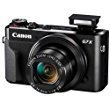 11.2 oz 20.1 MP
11.2 oz 20.1 MP
1080 FHD 8 fps $$4.7
SONY A6300
 14.2 oz 24.2 MP
14.2 oz 24.2 MP
4 K 11 fps $$$4.7
SONY A7R II
 22.0 oz 42.4 MP
22.0 oz 42.4 MP
4 K 5 fps $$$$4.9
OLYMPUS E-M5 II
 16.5 oz 16-40 MP
16.5 oz 16-40 MP
1080 FHD 10 fps $$$4.8
NIKON 5500
 16.6 oz 24.2 MP
16.6 oz 24.2 MP
1080 FHD 5 fps $$4.9
CANON REBEL T5
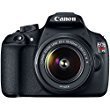 16.9 oz 18 MP
16.9 oz 18 MP
1080 HD 3 fps $4.6
NIKON D810
 34.5 oz 36.3 MP
34.5 oz 36.3 MP
1080 FHD 5 fps $$$$5.0
TYPES OF CAMERAS:
RUGGED CAMERAS
– For a lot of adventure and outdoor sports –Tough or rugged cameras have been on the market for a while, being popular among backpackers. They’re designed to be submersible down to 10 or 20 meters and withstand hard weather, hits and drops. There’s no doubt that these features make them a great choice for climbing, snorkeling, surfing, cycling, etc. However, these cameras tend to be expensive due to their solid construction and the internal components, like the sensor, aren’t the best. They’ll do the job, but don’t expect amazing image quality.
ACTION CAMERAS
– For recording high-quality video while practicing sports –These are the GoPro-like cameras you’ve seen many times. If you take a look at the last GoPro 5, you’ll understand why it has become so popular among all kinds of travelers. It’s a great option for those who want to record high-quality videos at 4K while practicing outdoor sports. It’s small, lightweight and portable, and the batteries last for quite a while. It comes with image stabilization, so it feels more stable compared to previous models. There are many available accessories, so you can use a stick or a head mount, or even attach it to a drone.
POINT AND SHOOTS
– For entry-level photographers looking for something compact and affordable –These digital cameras are compact, easy to use and inexpensive (most of them). They’re probably the best option if you’re looking for something ultralight with decent image quality.Please notice that I said “decent” quality. If you’re not into technical photography, they’ll be a good option for recreational hiking and backpacking. At least, they take better photos than most smartphones do. Keep in mind that their sensors are usually 24mm at the wide end, which isn’t too good for landscape photography. If you want advanced features, changeable lenses and better optical quality, take a look at mirrorless and DSLR cameras.
MIRRORLESS
– For great performance at a reduced size –Mirrorless cameras are the latest revolution in the photo industry. They’ve become incredibly popular because they’re lighter than the bulkier DSLRs while offering top-end image and video resolutions. In a nutshell, they offer pretty much the same image quality as bulky reflex cameras while being ultralight and compact.Actually, some advanced mirrorless cameras offer even better quality than DSLRs of a similar price. You can take professional photos without adding much room to your backpack. Like DSLRs, they use changeable lenses, which gives you many new possibilities, improving landscape photography.The main downside: These cameras and their interchangeable lenses tend to be quite expensive.
DIGITAL SLR CAMERAS
– For serious photo lovers –DIGITAL SLR cameras are among the best cameras you can find in terms of sensor quality, features, components and lenses. These are the cameras that most professional photographers use. Keep in mind that they’re also expensive, bulky and heavy.I love photography almost as much as I do traveling, so I make a sacrifice and always carry a DSLR camera with me. It’s a personal choice. I know it’s bulky but when I look at the photos, I know it’s worth the effort. A few months ago I bought a Nikon 5500 and I think it’s perfect for travel. It’s not as heavy as other cameras (like the Nikon 7200), it’s not expensive for its quality, it’s super versatile and it takes amazing photos.Unless you’re planning to make a living out of photography, I’d never recommend that you buy a very expensive DSLR for backpacking and hiking. They have a solid body that makes them extra heavy. Plus, you never know … you could get robbed or lose it. Most budget DSLRs take awesome pictures. Keep in mind that you must also use a good lens.
REVIEW OF THE TOP 10 BEST HIKING CAMERAS
BEST RUGGED CAMERA
OLYMPUS TG-4 TOUGH
WEIGHT: 8.7 oz
SENSOR: 16 MP
S. SPEED: 5 fps
VIDEO: 1080 FHD
FOCAL LENGTH: Equivalent 25 – 100mm
PROS: Waterproof, resistant
CONS: Sensor“Super resistant” 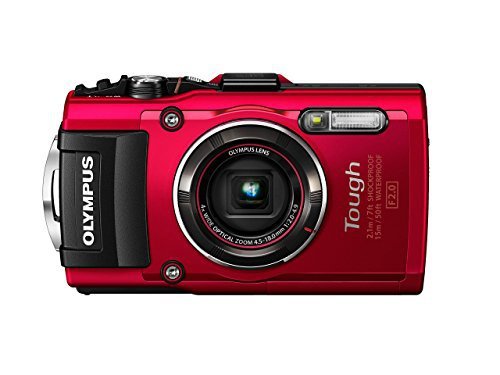
Check price on AmazonThe Olympus TG-4 Touch is a good option for those who need a really resistant camera for outdoor sports.It’s waterproof down to 50 feet, shockproof to seven feet and dustproof, and it withstands low temperatures (14ºF – 10Cº). The focal length is 4.5 – 18mm (35mm equivalent to 25 – 100mm). The widest focal length (25 mm) isn’t very wide, but it’ll do the job. If you really want to take wide landscapes, though, it’s not the best choice.It comes with many helpful adventure features, like: underwater mode, macro mode, live composite mode, built-in Wi-Fi connectivity, GPS and compass, and action modes. Even though you can’t change lenses, it offers the option to add lens converters. You can attach a fish-eye converter to capture wide shots and a telezoom converter to extend the zoom range.Overall, it’s portable, lightweight, versatile and resistant, and the image quality isn’t bad for a compact camera.
BEST ACTION CAMERA
GOPRO HERO 6
WEIGHT: 4.3 oz
SENSOR: 12 MP
S. SPEED: N/A
VIDEO: 4 K60
FOCAL LENGTH: 16 – 24mm
PROS: Water resistant, video
CONS: Only wide focal length“Great portability and video” 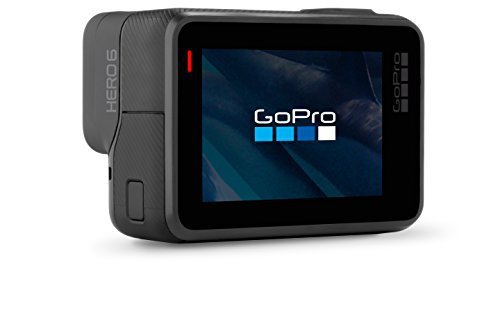
Check price on AmazonThe GoPro Black 6 is probably the best action camera you’ll find on the market right now. It features a two-inch touch display, voice control to activate the camera and amazing high-definition 4 K60 video. Unlike other GoPro models, it’s already waterproof down to 10 meters without the need for a housing. Of course, if you want to dive deeper, housings are available for that.It’s a great camera for backpacking, hiking and other outdoor sports because it’s super compact and ultralight, and the batteries last for a long time. It comes with an image stabilization system to capture smooth videos. The image quality of the sensor is quite good and the video resolution is impressive. The wide focal length of 16 – 24mm is perfect for adventure sports and landscape shooting.
POINT AND SHOOTS
SONY RX100 V
WEIGHT: 10.5 oz
SENSOR: 20.1 MP
S. SPEED: 24 fps
VIDEO: 4 K
FOCAL LENGTH: 24 – 70mm
PROS: Many features
CONS: Focal length“Great overall performance” 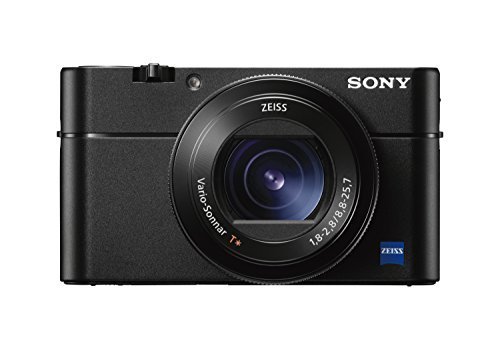
Check price on AmazonThe Sony RX100 V has become very popular among backpackers because it’s super lightweight and compact while having excellent performance. This baby takes really good photos for a point-and-shoot camera. It has a small sensor but takes 20.1 MP images and 4 K Full HD video. It’s equipped with many features, like: 315 phase detection AF points, continuous shooting at 24 fps, super slow motion and others. A wider focal length would be more versatile for landscape shooting, but it’ll do the job.If you’re planning to take underwater photos and videos, you can buy a housing and take it on your next dive. It’s also a fantastic camera for scuba diving.Many reviews have rated it the best compact camera on the market.
CANON POWERSHOT G7X MARK II
WEIGHT: 11.2 oz
SENSOR: 20.1 MP
S. SPEED: 8 fps
VIDEO: 1080 FHD
FOCAL LENGTH: 24 – 100mm
PROS: Many features
CONS: Not the best video“Good value for the money” 
Check price on AmazonThe Canon Powershot G7 X Mark II is another great option among point and shoots. It features a nice three-inch touch LCD display, Wi-Fi connectivity, a remote shooting system, image Sync function and others. Overall, it’s a great camera for its price. Only two cameras are in the point-and-shoot selection, so I’d like to do a little comparison here:The Canon G7X has a bit more focal length, at a maximum 100 mm (having that extra telezoom might be helpful in some situations) and it’s much cheaper than its competitor. On the other hand, the Sony RX100 V has better overall performance. It shoots much faster, at 24 fps (compared to 8 fps), and records 4 K FHD video (compared to 1080).Both are compact, lightweight and portable, and have good sensors with 20.1 MP that shoot impressive pictures.
MIRRORLESS CAMERAS
SONY A6300
WEIGHT: 14.2 oz
SENSOR: 24.2 MP
S. SPEED: 11 fps
VIDEO: 4 K FHD
FOCAL LENGTH: Depends on lens
PROS: High quality
CONS: Kit lens is not impressive“Good deal in mirrorless” 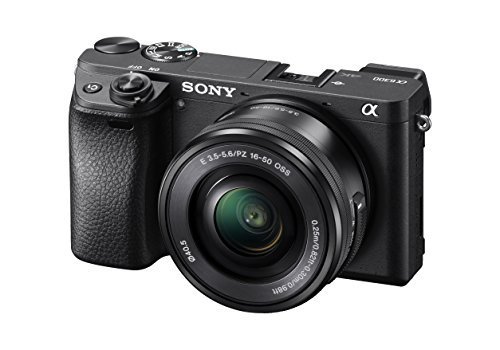
Check price on AmazonThe Sony A6300 is a popular choice among professional photographers. Many pros bring their Sony A6300 as a backup when they are taking outdoor photos. It’s equipped with a 24.2 MP sensor and takes impressive high-quality images and videos. At the same time, it’s weather sealed and costs much less than a pro DSLR.It’s compact, lightweight and reliable. The kit comes with a 16 – 50mm lens, which isn’t impressive. If you want to get the best out of this camera, consider buying another lens.
SONY A7R II
WEIGHT: 22.05 oz
SENSOR: 42.4 MP
S. SPEED: 5 fps
VIDEO: 4K FHD
FOCAL LENGTH: Depends on lens
PROS: Impressive quality
CONS: Expensive“Pro mirrorless camera” 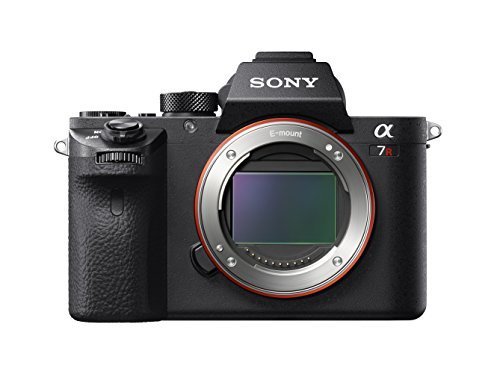
Check price on AmazonThe Sony A7R II is a professional full-frame camera for serious photographers. Considered by many as the best mirrorless on the market, it features a high-quality CMOS 42.4 megapixel sensor that matches the quality of most professional DSLRs.You’ll get the most advanced features, the quality of a top-end camera and the size and weight of a portable, compact device. Of course, there’s a price for all these features. It’s one of the most expensive cameras on the list.
OLYMPUS E-M5 MARKII
WEIGHT: 16.5 oz
SENSOR: 16 – 40 MP
S. SPEED: 10 fps
VIDEO: 1080 FHD
FOCAL LENGTH: Depends on lens
PROS: Good value for the money
CONS: No 4K video“Great quality” 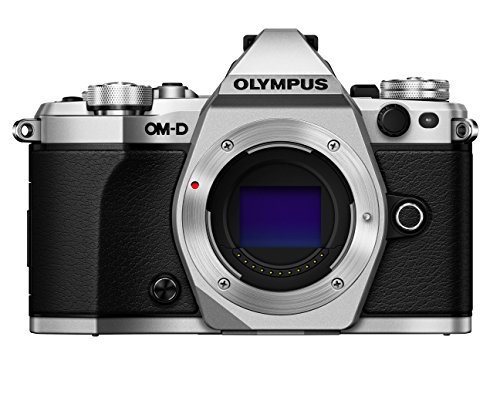
Check price on AmazonThe Olympus E-M5 Mark II is our last camera in the mirrorless section and it’s worth a look. It’s been a popular camera for a while because it takes very good pictures while being lightweight, compact and resistant. It features 5-axis image stabilization, 81-point selectable autofocus, a fully articulating touchscreen and a weatherproof body. It’s also quite a bit more affordable than the Sony A7R II.It’s one of the lightest mirrorless on the list if you’re looking for high quality without adding too much weight. The only downside is that, unlike the Sonys, it records video at only 1080 Full HD instead of 4 K FHD. In any event, that doesn’t have to be a deal-breaker. 1080p HD is still great video quality.
BUDGET DSLR
NIKON 5500
WEIGHT: 16.6 oz
SENSOR: 24.2 MP
S. SPEED: 5 fps
VIDEO: 1080 FHD
FOCAL LENGTH: Depends on lens
PROS: Great price and quality
CONS: Not the best video“Lightweight DSLR” 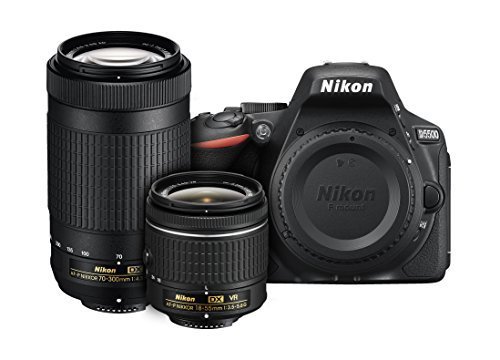
Check price on AmazonThe Nikon 5500 is the camera I’m using right now and I’m very happy with its performance. Not only does it take impressive pictures, it also feels very light and compact for a DSLR camera. I was about to buy a Nikon 7200, which has a better sensor and image quality, but I didn’t want to carry a heavy camera during my travels.Among DSLRs, the Nikon has the perfect balance among image quality, weight and size. It’s easy to use, and features a nice articulating touch display, built-in Wi-Fi and special effects. If you want to spend some money, you can invest in a few good lenses and take unforgettable shots.
CANON REBEL T5
WEIGHT: 16.9 oz
SENSOR: 18 MP
S. SPEED: 3 fps
VIDEO: 1080 HD
FOCAL LENGTH: Depends on lens
PROS: Price
CONS: Not the best performance“Budget-friendly DSLR” 
Check price on AmazonThe Canon Rebel T5 is a great option for entry-level photographers. It’s equipped with an 18 MP APS-C sensor that takes impressive pictures. However, if you can spend a bit more, the Nikon 5500 has a better sensor and more megapixels.Overall, it’s a great option if you want a decent DSLR camera for a very reasonable price. Keep in mind that DSLR cameras are quite bulky.
TOP-END DSLR
NIKON D810
WEIGHT: 34.5 oz
SENSOR: 36.3 MP
S. SPEED: 5 fps
VIDEO: 1080 FHD
FOCAL LENGTH:
PROS: Great sensor, pro
CONS: Expensive, heavy“Top quality” 
Check price on AmazonThe Nikon D810 is one of the best full-frame DSLR cameras you can find right now. For most people, it’s just out of reach because of the price, so I would recommend it only for professional photographers looking for the best image quality and performance.It doesn’t record at 4K but thanks to its full-frame sensor, the 1080p videos look like real movies. Keep in mind that it’s quite heavy and expensive.
OTHER ITEMS YOU MIGHT LIKE:
LIGHTWEIGHT TRIPOD
A lightweight tripod might be of great help for some types of photos and effects. If you’re planning to take one of those night photos with a nice sky full of stars, you’ll need one. 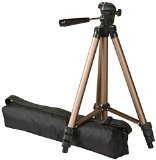
G-RAPHY BACKPACK
A camera backpack will help protect your camera from ugly weather conditions and keep it safe while you take buses and trains. 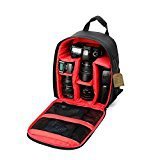
WHAT YOU NEED TO KNOW BEFORE BUYING A CAMERA FOR HIKING AND BACKPACKING:
1- WEIGHT AND SIZE
Whether it’s a compact point and shoot or a bulky full-frame DSLR, you’ll be adding some weight to your backpack. The point here is, how much weight is acceptable to carry while backpacking? Most hikers and backpackers already bring “must-have” gear like tents, sleeping bags, sleeping pads, pants, etc. It’s up to you to decide how much gear and weight you’re bringing. I think that bringing a DSLR camera with me is the only exception I make in terms of carrying ultralight gear.Point and shoots and action cameras are the lightest options on the list. Some models are incredibly ultralight. They don’t use changeable lenses, so even carrying all the batteries, memory cards, cables, etc., you don’t add much weight.Mirrorless are the second lightest option. They’re certainly lighter than most DSLR cameras. However, keep in mind that you’ll probably want to use several lenses, which means carrying more gear and adding weight.DSLRs are the heaviest cameras on the list. Budget models can actually be as light as mirrorless cameras because they feature a simple body construction. However, if you take a look at professional models, you’ll see the difference. They have reinforced bodies and advanced features that make them really heavy. I don’t recommend a top-end camera for backpacking and hiking.
2- SENSOR
If you want a camera with high image quality, you have to look at the sensor. The final result will depend on the type of sensor, the megapixels, the ISO sensitivity, the lens and other factors.However, it’s important to highlight the fact that a good image sensor is what makes images good. Don’t assume that high-megapixel cameras take better photos because of the high number of pixels. For most people, megapixels shouldn’t matter much. A 20 MP compact camera isn’t ever going to be as good as a 12 MP Full Frame DSLR. For regular people who will look at the pictures on the computer or who will print them at 10×15 or 13×18 cm, you don’t need 32 MP!What matters is the quality and the size of the sensor.
3- WEATHER SEALING
You need to consider whether your camera should be weather sealed. This will depend entirely on the use and the activities in which you’re planning to participate. Weather sealing reduces the exposure of the internal components to moisture, debris, water and dust. Most tough and action cameras are equipped with this feature (or provide a protection case) because they’re designed to withstand the worst conditions.This doesn’t always mean the camera is totally waterproof but it provides better protection during hard weather conditions. If you’re in the outdoors quite often, exposed to rain, dust, etc., it might be an important feature to consider.Otherwise, if you take good care of your camera and go hiking in poor weather just a few times a year, it can be an extra feature you don’t need.
4- LENS
Lenses are another key factor in determining image quality. Whether it’s a telezoom, a fish-eye or a fixed 50mm, the quality of the lens and its construction will make a difference in terms of the final result. Keep in mind that adjustable lenses like 18-200mm, 27-55mm, etc. are super versatile but don’t provide the same quality as fixed lens do. These are good for beginners and a good option for outdoor shooting. On the other hand, having a fixed lens means that you must change lens all the time depending on the scene and the type of photo.Point-and-shoot cameras include built-in lenses with average quality but a really good zoom. They’re usually 24mm at the wide end, which isn’t the best option for landscape photography (but acceptable). Most mirrorless and DSLR cameras come in a kit with 18-55mm and 27-70mm lenses or similar.
WHAT’S THE IDEAL FOCAL LENGTH?
There are hundreds of lenses on the market and sometimes it’s hard to determine which lens you need. Your choice will depend on the type of photography you like and the versatility you need. Wide-angle lenses shoot a wider angle and, thus, capture a bigger part of the scene. Telephoto lenses can take photos from a distance, showing a narrow part of the scene on the sensor.For hiking photography, you’ll want to buy a true wide-angle lens. This way, you can shoot wide landscapes and capture all the scenery. Most hiking photos are lakes, mountains and other landscapes, so 16mm to 20mm is a good length range. Anything narrower than 24mm will make you lose part of the landscape and the result won’t be very good.If you want to take pictures of animals and people from a distance, telephoto lenses like 140mm, 200mm or 300mm would be of great help.
HOW TO TAKE CARE OF YOUR CAMERA:
If you’re interested in prolonging the life of your new camera, follow these tips on how to keep your camera and lenses free of grit and grime. You’ll improve the functionality and durability of your photo gear. The main elements we want to avoid are dirt, dust, sand, water, smoke, extreme heat, extreme cold and humidity. I know, you’ll be shooting outdoors and won’t be able to avoid all those things. At least try to protect your camera as much as you can.A camera backpack will be a good investment to improve its durability. You can keep other electronic gear in it depending on the size.For cleaning the camera body, lenses, buttons, dials and touch screens, get a basic cleaning kit. You can remove dust and debris from your camera and lens with a soft-bristled brush. If you’re cleaning a lens, extend it to its maximum length so you can clean the inner part.
– Cleaning the sensor:
You can use a hand air blower to blow debris and dust off the lens and camera sensor. Don’t use pressurized air, as the high pressure can damage the sensor. Remove your lens and set your camera to “manual cleaning”. When the mirror locks up, gently use the hand blower to remove any particles. Never touch the sensor with the hand blower or your fingers. Turn off the camera and the mirror will return to its normal position.
– Cleaning your lens:
Use a microfiber tissue to clean your lens. I recommend starting in the center of the lens and moving in a circular motion. You can use isopropyl alcohol.
WHICH ARE THE BEST BACKPACKING CAMERAS?
Do you still have doubts? Let me give you a few suggestions. If you want a lightweight camera with good image quality, the Sony RX 100V might be your best option. For those looking for high image quality at a reasonable price and weight, the Sony A6300 has incredible performance.If you want a DSLR camera with great resolution and at a good price, the Nikon 5500 will be the perfect choice.
I personally use a Lumix FZ300 which is absolutely yet powerful. It has fantastic 4k video capabilities and it's a superzoom meaning you can get some absolutely fantastic shots. Great list and I'm sure it's gonna help at least a couple of people picking out their next piece of gear.
Keep it up.
Downvoting a post can decrease pending rewards and make it less visible. Common reasons:
Submit
its gonna help me for sure.
Downvoting a post can decrease pending rewards and make it less visible. Common reasons:
Submit
Good Stuff.
Downvoting a post can decrease pending rewards and make it less visible. Common reasons:
Submit
I can vouch for the Sony RX100
great camera small but easy to operate you can take it anywhere,
I LOVE IT.
Downvoting a post can decrease pending rewards and make it less visible. Common reasons:
Submit